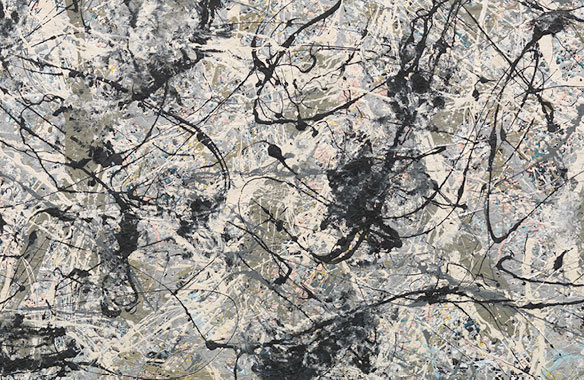CulBeat Express
2018.07.19 11:09
메트뮤지엄 추상표현주의 특별전 '폴락에서 헤레라까지'(11/28- )
조회 수 1105 댓글 0
Epic Abstraction: Pollock to Herrera
The Met Breuer, Floor 2

Jackson Pollock. Number 28, 1950 (detail), 1950. Enamel on canvas. The Metropolitan Museum of Art
Opening November 28 at The Met Breuer, Epic Abstraction: Pollock to Herrera begins in the 1940s and extends into the 21st century to explore large-scale abstract painting, sculpture, and assemblage through more than 40 works from The Met collection, a selection of loans, and never-before-seen promised gifts and new acquisitions. Enhanced in the setting of Marcel Breuer's 1966 modernist architectural masterpiece, icons of Abstract Expressionism, such as Jackson Pollock's classic "drip" painting No. 28, 1950 (1950), and Louise Nevelson's monumental Mrs. N's Palace (1964–77), will be shown in conversation with works by international artists, such as the Hungarian artist Ilona Keserü.
In the wake of unprecedented destruction and loss of life during World War II, many painters and sculptors working in the 1940s grew to believe that traditional easel painting and figurative sculpture no longer adequately conveyed the human condition. In this context, numerous artists, including Barnett Newman, Pollock, and others associated with the so-called New York School, were convinced that abstract styles—often on a large scale—most meaningfully evoked contemporary states of being. Many of the artists represented in Epic Abstraction worked in large formats not only to explore aesthetic elements of line, color, shape, and texture but also to activate scale's metaphoric potential to evoke expansive—"epic"—ideas and subjects, including time, history, nature, and existential concerns of the self.
Highlights of the exhibition will include a group of paintings by Pollock and a selection of his experimental sketchbook drawings from the late 1930s and early 1940s that demonstrate the artist's exploration of automatic techniques and his interest in Jungian psychoanalysis. Major works by Franz Kline, Willem de Kooning, Robert Motherwell, and Clyfford Still will expand the representation of mid-century American painting, while an entire room devoted to Mark Rothko's meditative compositions will offer a powerful immersion in color, feeling, and sensation. These heralded Abstract Expressionists will be joined by Hedda Sterne and Philippines native Alfonso Ossorio, who were also associated with the movement. A significant ink painting from 1966 by Japanese artist Inoue Yuichi will illuminate the international practice of large-scale calligraphic abstraction. Monumental painterly canvases by Joan Mitchell—a lyrical retort to Pollock's freighted whipping drips—and Mark Bradford—whose Duck Walk (2016) marks a recent addition to the collection—will evoke Abstract Expressionism's long and profound legacy.
The exhibition will also feature a gallery of works by the next generation of artists, including Edna Andrade, Carmen Herrera, Ellsworth Kelly, Kenneth Noland, Frank Stella, and Anne Truitt, who tamed the highly pitched emotionalism of Abstract Expressionism by working in the hard edge and minimalist styles that came to define modern art in the 1960s and 1970s. An adjacent gallery with key works by Helen Frankenthaler and Morris Louis will explore the reductive technique of staining canvas in painting.
The exhibition's largest gallery will present a range of works composed of found objects and repurposed materials, including the centerpiece of the installation, Nevelson's Mrs. N's Palace, and Thornton Dial's elegiac Shadows of the Field (2008), which evokes the history of American slavery. The spacious installation design will establish artistic and conceptual connections between the artists on view while encouraging visitors to contemplate individual works of art in isolation or in dialogue with others in their midst.
Epic Abstraction: Pollock to Herrera is curated by Randall Griffey, Curator in the Department of Modern and Contemporary Art at The Met.
In conjunction with the exhibition, a concert in the MetLiveArts Sight and Sound series, "Abstraction in Music and Art," will feature Leon Botstein and The Orchestra now performing works by the radical modernist Anton Webern and experimental composer Morton Feldman, who mirrored the Abstract Expressionist painters and took his inspiration from their art. The performance, on Sunday, May 19, 2019, at 2 p.m. in The Met Fifth Avenue's Grace Rainey Rodgers Auditorium, will be preceded by a discussion accompanied by musical excerpts performed alongside on-screen artworks. Tickets start at $40; $75 for the series; Bring the Kids for $1 tickets are also available (metmuseum.org/sightandsound).
The exhibition will be featured on the Museum's website, as well on Facebook, Instagram, and Twitter using the hashtag #EpicAbstraction.







